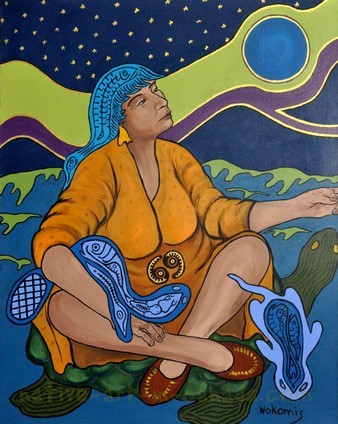For this week’s blog assignment I was assigned pages 242-259 (which ended up being pages 244-250 in my newer version of the text). This segment of the novel contains Latisha’s reflection on a time when George had quit his job and was attempting to take up the house duties in an effort to alleviate some of her stress. This is ironic for two reasons, firstly because the text begins with her waking up, exhausted, to find her youngest daughter Elizabeth standing in a poopy diaper and only Latisha is there to help her (as George left her before Elizabeth was born). Also the text starts and finishes with Georges absence, but is mainly focused around his failure to cook and provide for the family.
George Armstrong Custer as George Morningstar
Latisha’s love interest in the novel is an American named George Morningstar which is an allusion to General George Custer, from the American civil war. Both George’s have similar appearances, tall with shoulder length hair, and both originated from Ohio and were raised in Michigan (Eldatari, 2009). Another factor linking the two men was that they both wrote detailed letters to their wives/girlfriends about their “journeys” through America. For Custer, these were to his wife while he was active in the Civil war, and for Morningstar, the letters to Latisha were after he had abandoned her and her children (Eldatari, 2009).
General George Custer famously died while in battle with Native Americans at the Battle of Little Bighorn (Bio, 2015). George Morningstar’s disregard of native traditions throughout the book as well as his disrespect towards Latisha parallels the disrespect that General Custer had towards the Native Americans. Custer’s biggest mistake was his pride, which lead to his downfall when he attacked La Kota without reinforcements, ending in his death. Morningstar also “underestimates the reaction that he will receive by attending the Sun Dance, and is summarily dismissed for disobeying the rules and attempting to photograph the event” (Eldatari, 2009). Another interesting link between the two men is Elizabeth, the name of General Custer’s wife and also the name of Morningstar’s daughter, who Latish finds out she is pregnant with after Morningstar has abandoned her.
George Morningstar is American nationalism and foolishness at its finest. In the assigned reading segment, George is ludicrously attempting to play “house-wife” by buying cook books and un-necessary cooking gadgets, but is failing miserably at cooking (and his new role). The two allusions that allow the reader to recognize his stupidity (apart from his obvious failure cooking croissants and ratatouille) are the names of his trusted cookbooks. Sam Molina’s book on pasta is a pun on semolina, the flour used to make pasta’s, and David Karaway’s cookbook on bread is also a pun for caraway seeds which are generally put into rye breads for added texture/flavour (Flick, 1994).
Reflections
I found King’s allusion to George Custer to be very cunning and thought provoking. To begin with, the average reader may not understand the reference, unless they were familiar with the history of the American Civil War, as I myself did not. However the likeness between the two George’s is uncanny. From their physical descriptions to their actions and treatment of other characters in the story, both Georges are ‘failures’ of a sort. In this section of the text George Morningstar fails miserably at household work, especially cooking. Since he is unable to hold a job and cannot even provide for the family by cooking, his frustrations lead him to abandon them. Custer was a failure by his own stupidity, sending his men and himself into a battle without waiting for reinforcement, which ended in his death and many more. There is also a theme of heroism in Green Grass Running Water as most of the characters are strong, selfless, and independent people. Latisha shows many signs of heroism, raising a family on her own, running a successful business, and always standing up for herself and her beliefs. In the section I was assigned, Latisha’s strength was defiantly displayed as she reflected upon her unhelpful and absent husband, in an almost comedic manner as she describes his attempts and failures at supporting her family.
Work Cited
George Custer. Bio. A&E Television Networks, 2015. Web. 16 Mar. 2015.
Flick, Jane. (1994) “Reading Notes for Thomas King’s Green Grass Running Water”. Canlit. Harpour Collins.
“Semolina”. Wikapedia. Web. March 16, 2015. http://en.wikipedia.org/wiki/Semolina
Alfaro, Danilo. “Caraway”. About Food. Web. March 16, 2015. http://culinaryarts.about.com/od/glossary/g/Caraway.htm
Eldatari. (2009). “George Armstrong Custer and George Morningstar”. Lit Studies. Web. March 16,2015. https://litstudies.wordpress.com/tag/green-grass-running-water/
St. Rosemary Educational Institution. “Green Grass, Running Water Character Anaylsis.” http://schoolworkhelper.net/. St. Rosemary Educational Institution, Last Update: 2015. Web. March 16, 2015. http://schoolworkhelper.net/green-grass-running-water-character-anaylsis/.
“The battle of the Little Big Horn, 1876” Eye Witness to History. Web. March 16, 2015. http://www.eyewitnesstohistory.com/custer.htm


